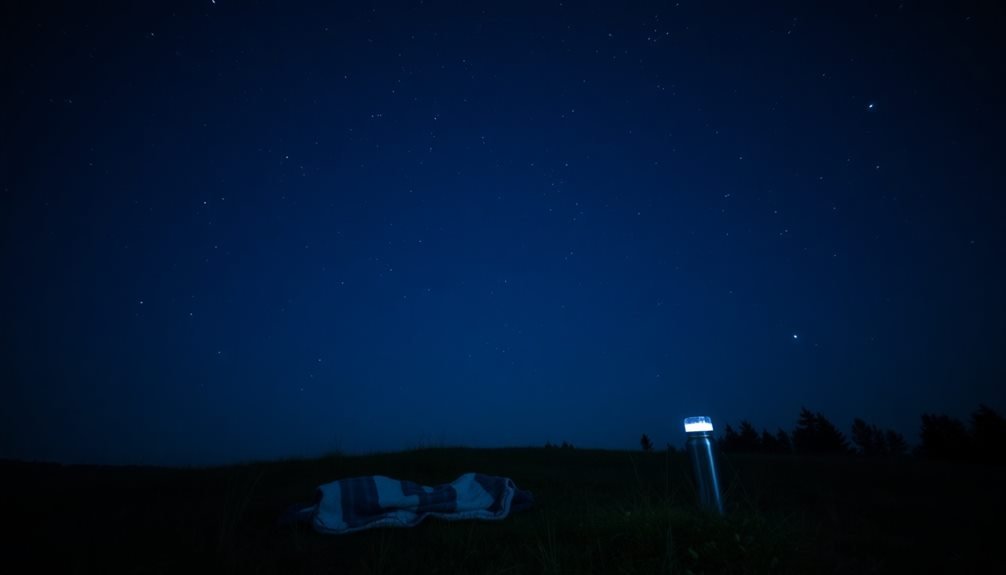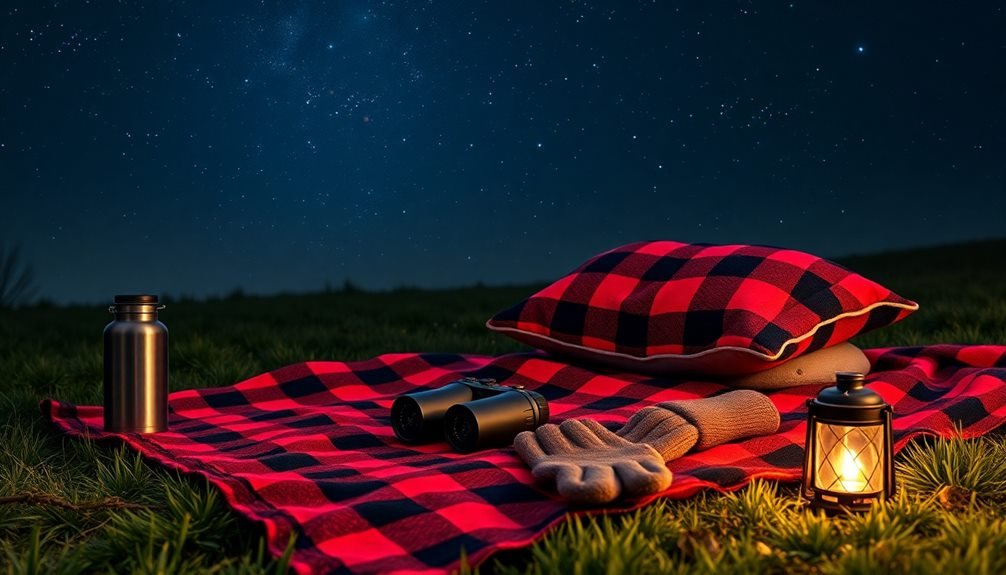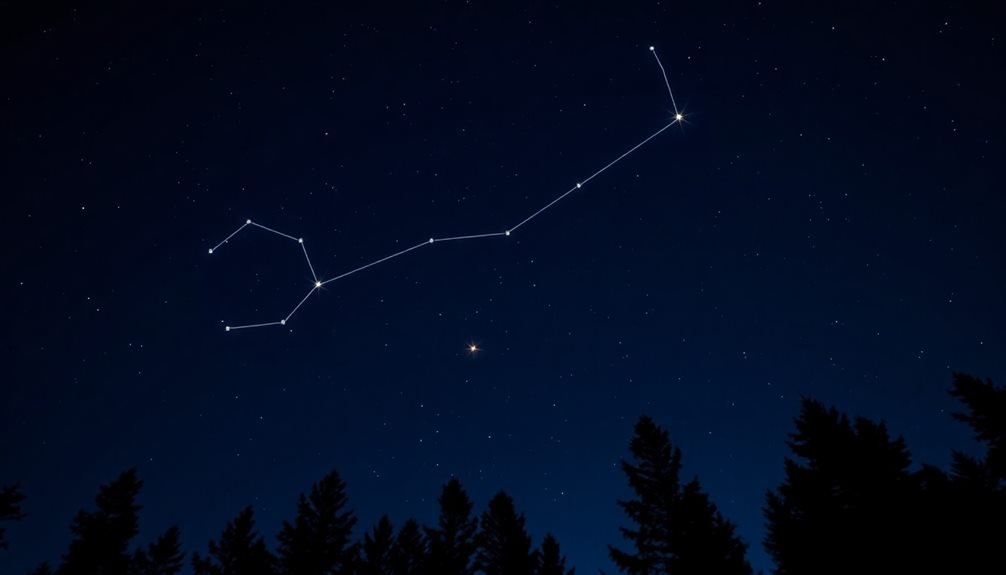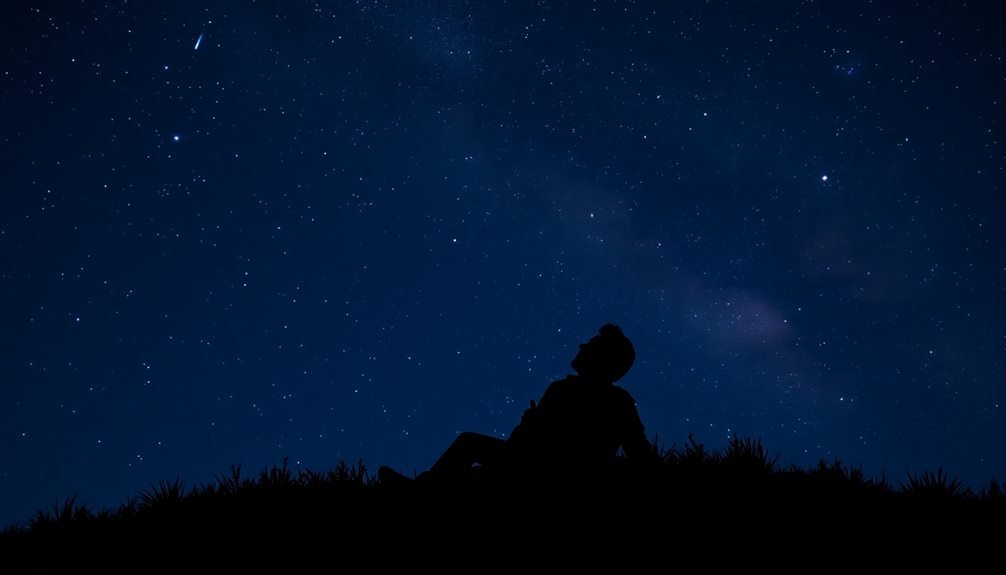Find your perfect stargazing spot away from city lights, ideally on a hilltop or beach with an unobstructed view. Time your sessions around the new moon between 9 PM and 1 AM, and let your eyes adjust for 30 minutes. Bring comfort essentials like a reclining chair, warm blankets, and quiet snacks. Download star navigation apps like Stellarium to help identify celestial objects. Learn basic navigation by locating Polaris and using the "star-hopping" technique. Start with easy-to-spot constellations like the Big Dipper and Orion's Belt. Practice mindful observation by focusing on your breathing and scanning systematically – there's a whole universe of celestial wonders waiting to be discovered.
Choose Your Perfect Stargazing Spot

When night falls, finding the right location makes all the difference in your stargazing experience. Look for areas away from city lights, tall buildings, and dense tree coverage that could obstruct your view of the night sky. The darker your surroundings, the more stars you'll be able to see.
Choose elevated locations like hilltops or open fields that provide a clear, unobstructed view of the horizon. You'll want to avoid valleys or low-lying areas where fog and moisture can accumulate and blur your celestial views.
If you're near the coast, beaches can offer excellent stargazing opportunities, as they typically have minimal light pollution and wide-open skies.
Consider accessibility and safety when selecting your spot. You'll need a stable surface to set up your viewing equipment, if you're using any. Bring a comfortable chair or blanket, as you'll likely spend extended periods looking upward.
Check the weather forecast before heading out – clear skies are essential for ideal viewing. Remember that your eyes need about 30 minutes to fully adjust to the darkness, so arrive early and let nature's light show begin.
Time Your Night Sky Sessions
Timing your stargazing sessions strategically will help you get the most enchanting views of the night sky.
You'll want to check dark sky charts that show when the moon isn't bright and consult monthly astronomical calendars that highlight meteor showers, planet alignments, and other celestial events.
A general rule is to start your observations about an hour after sunset, when twilight has fully faded and your eyes have adjusted to the darkness.
Dark Sky Timing Guidelines
What's the secret to a perfect stargazing session? Timing your dark sky viewing precisely can make the difference between a stellar experience and a disappointing one.
You'll want to check your local moon phase calendar and plan around the new moon when the sky's at its darkest. The best viewing typically occurs between 9 PM and 1 AM, when the atmosphere has settled after sunset.
Start monitoring weather patterns 48 hours before your planned session. You'll need clear skies with low humidity and minimal cloud cover.
Urban stargazers should wait until at least two hours after sunset to allow artificial lighting to diminish. If you're tracking specific celestial objects, download an astronomy app to predict their peak visibility times.
Consider seasonal timing too. Winter nights often provide clearer viewing conditions due to reduced atmospheric moisture, though you'll need to dress warmly.
Summer offers comfortable temperatures but shorter dark periods. Spring and fall present balanced conditions with moderate temperatures and reasonable dark-sky duration.
Don't forget to check your location's light pollution map – you might need to travel to darker areas during certain seasons when local conditions aren't ideal.
Best Monthly Viewing Calendars
Monthly viewing calendars serve as your essential roadmap to the night sky's most spectacular events. You'll find these invaluable tools help you track meteor showers, planet alignments, and lunar phases throughout the year. Most astronomy websites and apps update their calendars monthly, highlighting prime viewing opportunities for both beginners and experienced stargazers.
| Month | Key Events | Best Viewing Times |
|---|---|---|
| January | Quadrantids Meteor Shower, Full Wolf Moon | 9 PM – 2 AM |
| June | Summer Solstice, Honey Moon | 10 PM – 4 AM |
| December | Geminids Meteor Shower, Winter Solstice | 6 PM – 11 PM |
Download a reliable stargazing calendar app or bookmark trusted astronomy websites to stay current with celestial events. You'll want to mark your personal calendar for major astronomical phenomena like eclipses, conjunctions, and supermoons. Many calendars also include helpful details about visibility conditions, peak viewing times, and which direction to face for ideal observation. Remember to check these calendars at least a week ahead to prepare for upcoming events and coordinate your viewing schedule with weather forecasts.
Pack Essential Comfort Items

Pack a bundle of warm blankets to protect yourself from the night's chill as you explore the celestial wonders.
You'll find that a cushioned chair or padded mat can transform your stargazing experience from uncomfortable to pleasurable.
Don't forget to bring your favorite snacks and beverages to sustain your energy during extended observation sessions.
Warm Blankets For Comfort
Since stargazing often involves lying still for extended periods, bringing warm, comfortable blankets is essential for an enjoyable experience. You'll want to take into account both the ground layer and top covering to guarantee maximum comfort and warmth during your celestial observations.
| Blanket Type | Best Uses |
|---|---|
| Waterproof Ground Cover | Blocks moisture and dirt from seeping through |
| Memory Foam Pad | Provides cushioning against hard surfaces |
| Thermal Blanket | Maintains body heat in cold conditions |
| Weighted Blanket | Reduces anxiety and promotes relaxation |
Choose blankets based on your local climate and season. In summer, a light fleece might suffice, while winter stargazing requires insulated, weather-resistant options. You'll want to layer your blankets strategically: start with a waterproof base, add padding for comfort, and top it off with warm covers for temperature regulation.
Don't forget to bring extra blankets for unexpected temperature drops, which commonly occur during clear nights ideal for stargazing. If you're planning to stargaze with others, pack individual blankets to guarantee everyone stays comfortable at their preferred temperature level.
Cushioned Seating Makes Difference
Proper seating can transform your stargazing experience from uncomfortable to delightful.
You'll want to invest in a reclining chair that allows you to lean back comfortably while observing the night sky. Look for chairs with adjustable positions and sturdy frames that can support extended viewing sessions.
If you're planning to stargaze from the ground, bring a foam camping pad or inflatable cushion to provide essential support for your back and joints.
These portable options will protect you from the cold, hard earth while maintaining proper posture. You might also consider a zero-gravity chair, which distributes your weight evenly and reduces pressure points during long observation periods.
Don't forget to pack a few smaller cushions or pillows for additional support. They're perfect for propping up your neck when you're trying to focus on specific celestial objects.
If you're using a telescope, a padded stool at the right height will help you maintain a comfortable position while making adjustments.
Remember to choose water-resistant seating materials that can handle dewy conditions, and always test your setup before heading to your viewing location.
Snacks For Night Sky
Tasty snacks and refreshments elevate any stargazing session, keeping your energy levels steady throughout the night. When packing your astronomy provisions, opt for foods that won't create mess or require much handling in the dark. You'll want to maintain clean hands for adjusting your telescope and using star charts.
Pack your snacks in easy-to-access containers and consider foods that won't make noise when you're trying to maintain a peaceful atmosphere. Thermoses filled with hot beverages like coffee, tea, or hot chocolate help ward off the nighttime chill while providing a welcome energy boost.
- Trail mix with nuts, dried fruit, and dark chocolate offers sustained energy and is easy to grab by the handful.
- Pre-cut fruit and vegetables in sealed containers provide healthy hydration and natural sugars.
- Wrapped granola bars or energy bars make convenient, mess-free options that won't crumble.
Remember to bring water to stay hydrated, especially on warm nights. Store all food items in sealed containers to avoid attracting wildlife to your viewing spot, and don't forget to pack wet wipes for quick cleanup without needing to leave your observation post.
Download Reliable Star Apps
Several smartphone apps have revolutionized modern stargazing, making celestial navigation easier than ever. You'll find apps like Stellarium, Star Walk 2, and NASA's official app particularly useful for identifying constellations, planets, and other celestial objects in real-time.
To get started, download at least two reliable stargazing apps to cross-reference your findings. Make sure you're getting the official versions from your device's app store, as knockoffs won't provide accurate information. Most premium apps offer free trials, so you can test them before committing to a purchase.
Once you've installed your chosen apps, take time to learn their basic features. You'll want to enable your device's location services and calibrate your phone's compass for accurate sky mapping. Many apps offer augmented reality features – just point your phone at the sky, and they'll identify what you're seeing.
Don't forget to enable night mode within these apps to protect your dark-adapted vision. You can also download offline star maps for areas with poor cellular coverage, ensuring you won't lose your celestial guide when you're in remote viewing locations.
Master Basic Sky Navigation

While stargazing apps offer valuable guidance, learning to navigate the night sky with your own eyes builds a deeper connection to celestial observation. Start by locating Polaris, the North Star, which remains nearly stationary throughout the night. You'll find it by following the two pointer stars at the end of the Big Dipper's bowl. Once you've found Polaris, you've established your cardinal directions.
Master these fundamental navigation techniques to enhance your stargazing experience:
- Use the "star-hopping" method – move from bright, easily identifiable stars to locate fainter objects nearby, much like following a celestial roadmap.
- Learn seasonal anchor points – memorize one major constellation for each season, such as Orion for winter or Scorpius for summer, to help orient yourself.
- Practice the fist method – extend your arm and use your fist to measure roughly 10 degrees of sky, helping you gauge distances between celestial objects.
Remember that the Earth's rotation makes the stars appear to move from east to west throughout the night. You can use this predictable motion to track celestial objects and plan your viewing sessions more effectively.
Start With Major Constellations
Learning the major constellations serves as your foundation for deeper night sky exploration.
Begin with the Big Dipper, which isn't technically a constellation but part of Ursa Major (Great Bear). You'll find it's one of the easiest patterns to spot in the Northern Hemisphere and acts as a reliable pointer to other stars.
Focus next on Orion, the Hunter, visible during winter months. Its distinctive three-star belt and bright corner stars Betelgeuse and Rigel make it unmistakable.
In summer, look for the Summer Triangle, formed by the bright stars Vega, Deneb, and Altair from different constellations.
Learn to spot Cassiopeia's distinctive W-shape near the north celestial pole, which appears opposite the Big Dipper from Polaris.
The zodiac constellations like Leo, Scorpius, and Taurus follow the ecliptic path across the sky where planets travel.
Don't try to learn all constellations at once. Master these major ones first, and you'll develop reliable reference points for locating fainter constellations.
Use your smartphone's astronomy app to confirm identifications until you're confident in your visual recognition skills.
Practice Mindful Sky Observation

To fully appreciate the night sky, you'll need to cultivate patience and mindfulness during your stargazing sessions. Let your eyes adjust naturally to the darkness for at least 20 minutes, and resist the urge to check your phone or other bright devices.
Focus on your breathing while scanning the vast expanse above, allowing yourself to become fully present in the moment.
Develop a systematic approach to observing the night sky. Start from a specific point, like the North Star, and gradually work your way across the celestial sphere. This methodical practice will help you build familiarity with star patterns and deepen your connection to the cosmos.
Practice these mindful observation techniques to enhance your stargazing experience:
- Find a comfortable position and remain still – unnecessary movement can disrupt your focus and eye adaptation
- Use averted vision by looking slightly to the side of dim objects, allowing your eyes' more sensitive peripheral vision to detect faint stars
- Count stars within a specific constellation or area to maintain concentration and improve your observation skills
Remember that mindful stargazing isn't just about identifying celestial objects – it's about creating a peaceful connection with the universe above.
Frequently Asked Questions
Can Light Pollution Permanently Damage Night Vision While Stargazing?
No, light pollution won't permanently damage your night vision while stargazing. However, it'll temporarily impair your eyes' ability to adjust to darkness. You can regain full night vision after 30-45 minutes in darkness.
How Do Astronomical Events Like Solar Flares Affect Constellation Visibility?
You won't notice solar flares affecting constellation visibility directly, but they can create auroras that might outshine dimmer stars. During intense solar storms, these colorful displays could temporarily overwhelm some constellation patterns.
Why Do Some Stars Appear to Change Colors When Viewed?
You'll notice stars twinkle and change colors because Earth's atmosphere bends and scatters their light. When starlight travels through turbulent air layers, it creates this shimmering effect with varying hues you observe.
What Causes Certain Constellations to Appear Upside Down in Different Hemispheres?
You'll see constellations appear inverted between hemispheres because you're viewing them from opposite sides of Earth. As our planet rotates, your perspective shifts, making celestial patterns appear flipped relative to your location.
Does Air Pollution Affect the Accuracy of Star Color Identification?
Yes, air pollution greatly affects how you'll perceive star colors. When you're observing through smog and particulates, they'll scatter and distort the star's true colors, making it harder to identify them accurately.
In Summary
You'll discover that stargazing becomes more rewarding with each night spent under the stars. By following these tips and making them part of your routine, you'll soon navigate the night sky like a pro. Remember, it's not about rushing to spot everything at once – take your time, stay comfortable, and let the celestial wonders unfold before your eyes. The universe awaits your exploration.





Leave a Reply